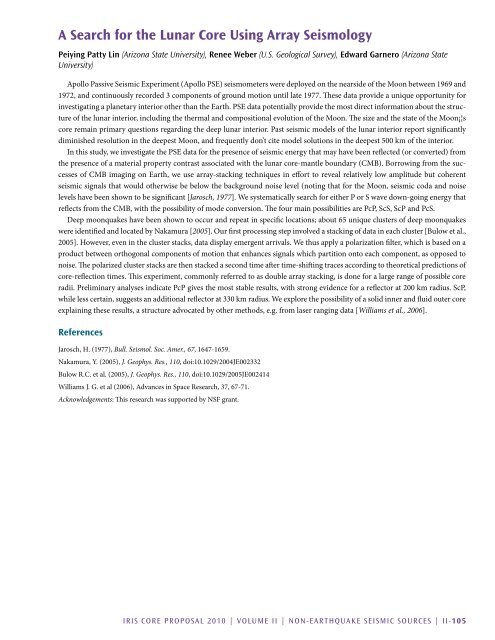Accomplishments - IRIS
Accomplishments - IRIS
Accomplishments - IRIS
Create successful ePaper yourself
Turn your PDF publications into a flip-book with our unique Google optimized e-Paper software.
A Search for the Lunar Core Using Array Seismology<br />
Peiying Patty Lin (Arizona State University), Renee Weber (U.S. Geological Survey), Edward Garnero (Arizona State<br />
University)<br />
Apollo Passive Seismic Experiment (Apollo PSE) seismometers were deployed on the nearside of the Moon between 1969 and<br />
1972, and continuously recorded 3 components of ground motion until late 1977. These data provide a unique opportunity for<br />
investigating a planetary interior other than the Earth. PSE data potentially provide the most direct information about the structure<br />
of the lunar interior, including the thermal and compositional evolution of the Moon. The size and the state of the Moon¡¦s<br />
core remain primary questions regarding the deep lunar interior. Past seismic models of the lunar interior report significantly<br />
diminished resolution in the deepest Moon, and frequently don’t cite model solutions in the deepest 500 km of the interior.<br />
In this study, we investigate the PSE data for the presence of seismic energy that may have been reflected (or converted) from<br />
the presence of a material property contrast associated with the lunar core-mantle boundary (CMB). Borrowing from the successes<br />
of CMB imaging on Earth, we use array-stacking techniques in effort to reveal relatively low amplitude but coherent<br />
seismic signals that would otherwise be below the background noise level (noting that for the Moon, seismic coda and noise<br />
levels have been shown to be significant [Jarosch, 1977]. We systematically search for either P or S wave down-going energy that<br />
reflects from the CMB, with the possibility of mode conversion. The four main possibilities are PcP, ScS, ScP and PcS.<br />
Deep moonquakes have been shown to occur and repeat in specific locations; about 65 unique clusters of deep moonquakes<br />
were identified and located by Nakamura [2005]. Our first processing step involved a stacking of data in each cluster [Bulow et al.,<br />
2005]. However, even in the cluster stacks, data display emergent arrivals. We thus apply a polarization filter, which is based on a<br />
product between orthogonal components of motion that enhances signals which partition onto each component, as opposed to<br />
noise. The polarized cluster stacks are then stacked a second time after time-shifting traces according to theoretical predictions of<br />
core-reflection times. This experiment, commonly referred to as double array stacking, is done for a large range of possible core<br />
radii. Preliminary analyses indicate PcP gives the most stable results, with strong evidence for a reflector at 200 km radius. ScP,<br />
while less certain, suggests an additional reflector at 330 km radius. We explore the possibility of a solid inner and fluid outer core<br />
explaining these results, a structure advocated by other methods, e.g. from laser ranging data [Williams et al., 2006].<br />
References<br />
Jarosch, H. (1977), Bull. Seismol. Soc. Amer., 67, 1647-1659.<br />
Nakamura, Y. (2005), J. Geophys. Res., 110, doi:10.1029/2004JE002332<br />
Bulow R.C. et al. (2005), J. Geophys. Res., 110, doi:10.1029/2005JE002414<br />
Williams J. G. et al (2006), Advances in Space Research, 37, 67-71.<br />
Acknowledgements: This research was supported by NSF grant.<br />
<strong>IRIS</strong> Core Proposal 2010 | Volume II | Non-earthquake Seismic Sources | II-105

















